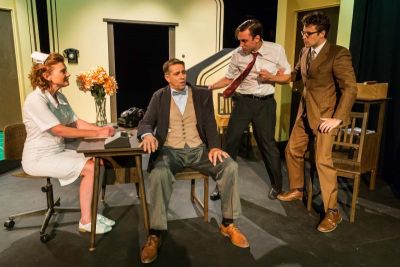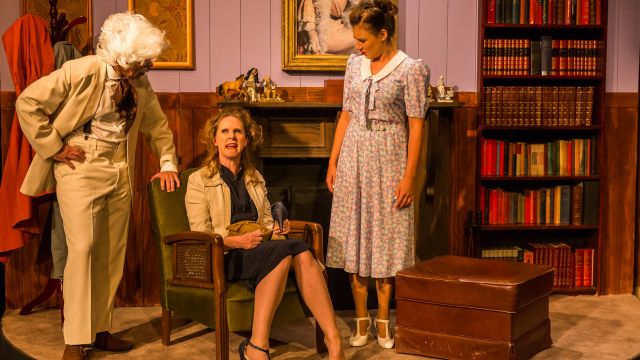Harvey
A movie starring James Stewart and five television productions have made Harvey famous on the big and little screen. But the original play by Mary Chase has also had a long and enviable stage history. After opening on Broadway in 1944 it ran until 1949, with a total of 1775 performances. Openings followed in London (1949) and Paris (1950). It was revived on Broadway in 1970 and London in 1975, both with James Stewart recreating his movie role. More recent revivals (Broadway 2012, London 2015) indicate the enduring appeal of this ‘treasure’ of the 1940s.
Elwood P. Dowd is a gregarious man who has been befriended by a Pooka – a helpful, mythical Celtic creature – in the form of an invisible six-foot plus rabbit called Harvey. The sociable Elwood introduces Harvey to everyone he meets, much to the growing embarrassment of his sister, Veta Lousie Simmons and her daughter Myrtle Mae. As a last resort, they decide to have him committed to a psychiatric clinic called Chumley’s Rest. When the much-mortified, and increasingly over-wrought Veta tries to explain her brother’s condition, she herself is incarcerated and confusion reigns.
Harvey is a comedy of errors, where moments of farce are juxtaposed with the calm nonchalance of Elwood himself who is blissfully unaware of the concern he causes and mayhem that arises from the muddle at Chumley’s Rest. The mixture of style and pace requires clear direction and precise timing and director Meredith Jacobs has ensured both. The production is crisp, the characters clearly defined and the attention to recreating the period is meticulous.
The set design is heavily reminiscent of the times. Wainscot panels, sombre colours, ‘substantial’ furniture and a portrait of his mother above the fireplace make Elwood’s home distinctly 1940s America. The offices of Chumley’s Rest, revealed after a clever turn of the set, are similarly suggestive of the times. The lighting (James Winters) emphasises the precision and detail of the set. The wigs and hair styles (Jacobs herself) and the costumes (Annette Snars) show fine attention to authenticity and an eye for flair.
 Chris Lundie is relaxed and gently convincing as Elwood P. Dowd. Lundie has a quiet, unpretentious but commanding stage presence. He inhabits Elwood’s character gracefully, emphasisng his generosity, trust and gentlemanly manners. He includes the invisible Harvey with an attentive ear and private, friendly smiles.
Chris Lundie is relaxed and gently convincing as Elwood P. Dowd. Lundie has a quiet, unpretentious but commanding stage presence. He inhabits Elwood’s character gracefully, emphasisng his generosity, trust and gentlemanly manners. He includes the invisible Harvey with an attentive ear and private, friendly smiles.
Leigh Scanlon plays his less relaxed sister, Veta. Hiding an edgy tenseness underneath a composure that is easily shaken, Scanlon takes Veta from taut control, to jumpy anxiety, to quivering anger in a performance that requires carefully judged comedic timing.
Kate Gandy as Myrtle Mae is a remarkably stylish 1940s debutant, and Jacqui Wilson is flirtatiously competent as nurse/receptionist Ruth Kelly.
The ‘cameo’ female parts in this play, though small, are cleverly drawn. Annette Snars is poised but slightly non-plussed as Mrs Ethel Chauvenet. Penelope Johnson doubles as Betty Chumley and a very imperturbable taxi driver. Sandy Moffat makes a very brief appearance as Miss Johnson.
The male characters all fall prey to the enigma that is Elwood P. Dowd. Their frustrations take the play into farcical moments that are comic contrasts to Elwood’s straight calm. Jason Spindlow is a zany orderly, Julian Floriano an ambitious young psychiatrist, Dave Went his the smug, up-tight, boss. Jeremy Johnson dons a white wig and white flannels to play the rather dotty Judge Omar Gaffney. And, of course, Harvey plays himself!
The production is a polished tribute to a classic American play.
Carol Wimmer
Images: (top) L-R: Jeremy Johnson, Leigh Scanlon and Kate Gandy, & (lower) Jackquie Wilson, Chris Lundie, Jason Spindlow, Julian Floriano. Photographer: Bob Seary.
Subscribe to our E-Newsletter, buy our latest print edition or find a Performing Arts book at Book Nook.

